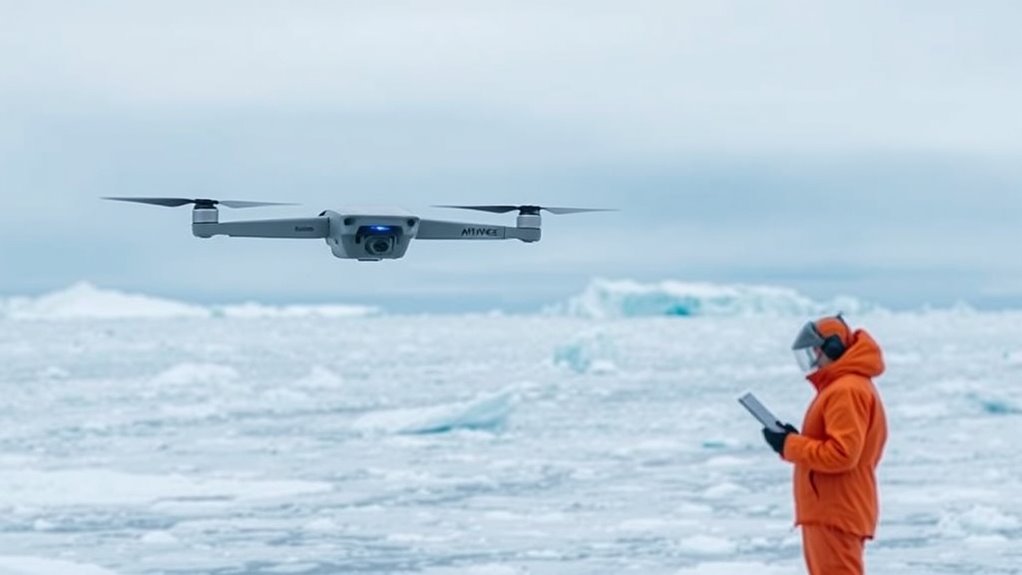Artificial intelligence is reshaping polar science by enabling you to analyze satellite images and seafloor data in seconds, not hours. It helps identify rare species, monitor environmental changes, and predict sea ice shifts in real-time. AI tools improve research efficiency, support conservation, and inform policy decisions for fragile ecosystems. If you keep exploring, you’ll discover how these algorithms are pushing the boundaries of environmental understanding in Earth’s most extreme regions.
Key Takeaways
- AI enables rapid identification and analysis of seafloor species, transforming traditional research timelines from hours to seconds.
- Machine learning models forecast sea ice and ecological changes, supporting real-time decision-making in polar environments.
- Integration of satellite and sensor data with AI improves understanding of climate impacts and biodiversity patterns.
- AI-driven tools facilitate broader spatial coverage and immediate data processing during expeditions, enhancing research efficiency.
- Combining AI insights with Indigenous knowledge aids in developing sustainable policies and protecting vulnerable polar ecosystems.

Ever wondered how artificial intelligence is transforming polar science? AI is revolutionizing how we explore and understand some of the planet’s most extreme environments. One of the most exciting advances is in marine biology and seafloor exploration. With AI, you can detect Antarctic seafloor animals in images within seconds—what used to take hours. This speed boosts research efficiency and allows for broader spatial coverage, giving you a richer picture of these cold habitats. When onboard research vessels, new AI tools enable real-time labeling of seafloor photographs, so you can analyze data immediately, rather than waiting for post-expedition processing. It’s essential because over 94% of Southern Ocean species call the Antarctic seafloor home, many uniquely adapted to survive in freezing conditions. Many of these species are at risk due to climate change, so AI’s ability to quickly identify and monitor critical habitats helps prioritize conservation efforts. Combining AI with expert validation ensures high accuracy while drastically reducing identification times from eight hours to mere minutes. This rapid data processing enhances your understanding of delicate ecosystems, guiding effective protection measures.
Meanwhile, the British Antarctic Survey’s AI Lab is developing machine learning models that forecast sea ice, monitor ecology, and track environmental changes. Their IceNet system, for instance, uses deep learning to analyze high-resolution satellite imagery, automatically detecting sea ice, icebergs, and shifts in ice sheet positions. These predictions help you and other decision-makers manage polar ecosystems better. Collaborations with ecologists and conservation agencies foster decision-support tools that turn AI predictions into actionable insights, improving your ability to respond to environmental shifts.
In the Arctic, AI and machine learning connect domain experts with vast data repositories, tackling complex problems like remote sensing, biodiversity estimation, and soundscape analysis. These tools help you model and predict ecological dynamics, revealing subtle patterns in satellite and sensor data related to climate change and biomass fluctuations. AI workflows integrate diverse datasets, supporting better decision-making based on both data and expert knowledge. By fusing traditional Indigenous knowledge with modern technology, you can develop more thorough scenarios of Arctic futures, guaranteeing sustainable policies that respect local insights. Overall, AI’s influence in polar science empowers you to explore, protect, and sustainably manage some of Earth’s most essential and vulnerable regions.
Frequently Asked Questions
How Does AI Improve Data Collection in Remote Polar Regions?
AI improves data collection in remote polar regions by enabling autonomous systems like UAVs and AUVs to gather continuous, high-quality data without human presence. It helps these platforms interpret incoming information in real time, adjusting routes and focus areas for ideal results. AI also filters and prioritizes relevant signals from vast sensor data, reducing bandwidth needs and increasing efficiency, all while enhancing safety in harsh environments.
What Are the Limitations of AI in Harsh Polar Environments?
AI faces a rocky road in polar environments, like a ship battling icy waters. You’ll find data limitations due to sparse, uneven datasets and environmental hurdles like extreme cold and shifting ice that hamper sensor performance. Additionally, complex models often act like black boxes, making results hard to interpret. Limited infrastructure, intermittent satellite coverage, and high energy demands further challenge reliable AI deployment, slowing progress in these unforgiving regions.
Can AI Predict Future Changes in Polar Ecosystems?
Yes, AI can predict future changes in polar ecosystems by analyzing satellite data, climate models, and local observations. You can leverage machine learning to forecast habitat shifts, migration patterns, and ice melt impacts. However, your predictions are only as good as the data you feed into the models. Continually updating with real-time information and integrating indigenous knowledge helps improve accuracy and relevance for ecosystem management.
How Is AI Helping to Monitor Polar Ice Melt More Accurately?
AI helps you monitor polar ice melt more accurately by processing vast amounts of satellite and sensor data quickly. It uses machine learning and deep learning to identify ice features, detect meltwater, and predict melting patterns. With real-time data integration from multiple sources, AI enhances your ability to track changes precisely, enabling better forecasting, operational planning, and informed decision-making for climate and maritime safety.
What Ethical Considerations Arise From AI Use in Polar Research?
Isn’t it crucial to guarantee your AI tools in polar research are ethically sound? You must consider principles like fairness, transparency, and privacy. Be aware of biases in data that could skew results, and involve diverse stakeholders to promote inclusivity. Protect sensitive information, assess environmental impacts, and foster public trust through open communication. Prioritizing these ethical considerations safeguards both the integrity of research and the communities involved.
Conclusion
You see, artificial intelligence transforms polar science by revealing new insights, by accelerating data analysis, and by enhancing decision-making. It helps you understand ice patterns, predict climate changes, and protect fragile ecosystems. With AI, you can explore unseen data, uncover hidden trends, and make smarter choices. As technology advances, your ability to study, preserve, and adapt to polar environments grows stronger. In this way, AI empowers you to face the future of polar science with confidence and clarity.










